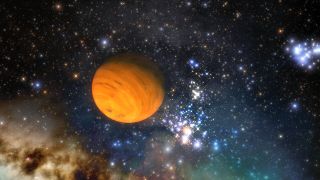
Astronomers have discovered dozens of new "rogue" planets, roughly doubling the known number of these mysterious free-roaming worlds.
A team of researchers found a collection of at least 70 exoplanets without parent stars — the largest single group of rogue planets ever found — in a patch of space about 420 light-years from Earth, a new study reports.
"We did not know how many to expect and are excited to have found so many," study lead author Núria Miret-Roig, an astronomer at the Laboratoire d’Astrophysique de Bordeaux in France and the University of Vienna in Austria, said in a statement.Most exoplanets are found via observations of their host stars. Astronomers notice slight stellar motions induced by the gravitational tug of an orbiting planet, for example, or spot tiny brightness dips caused when a world "transits" its parent star's face.
Such strategies cannot work for rogue planets, so these worlds are considerably harder to find. Astronomers have generally relied upon a technique called gravitational microlensing, which involves watching foreground objects move in front of background stars. During such passages, the foreground body can act as a gravitational lens, bending the distant star's light in ways that can reveal the closer object's mass and other features.
But that's not what Miret-Roig and her team did. They analyzed 20 years' worth of imagery and other data collected by a variety of telescopes on the ground and in space, including the European Southern Observatory's Very Large Telescope in Chile, Japan's Subaru Telescope in Hawaii, the European Space Agency's Gaia spacecraft and the Dark Energy Camera, an instrument mounted on the 4-meter Victor M. Blanco Telescope at the Cerro Tololo Inter-American Observatory in Chile.
"We measured the tiny motions, the colors and luminosities of tens of millions of sources in a large area of the sky," Miret-Roig said. "These measurements allowed us to securely identify the faintest objects in this region, the rogue planets.
Related stories:
The researchers saw infrared energy emitted by 70 to 170 gas-giant rogue planets, they report in the new study, which was published online today (Dec. 22) in the journal Nature Astronomy. (Young rogues of this heft glow with the heat of their formation for the first few million years of their lives.)
The range stems from uncertainty: The observations did not allow the team to nail down the observed bodies' exact masses, and objects at least 13 times more massive than Jupiter are likely to be "failed stars" known as brown dwarfs rather than planets.
The new results bolster the idea that rogue planets are common throughout the Milky Way galaxy, perhaps even outnumbering "normal" worlds that orbit parent stars.
And further investigation of these newfound worlds, and others like them, could help astronomers better understand how rogue planets come to be, study team members said. For example, do most of them form solo, condensing from a cloud of material too small to produce a star? Or are rogues usually born in "normal" solar systems but booted into the vast dark void by dramatic gravitational interactions?
Mike Wall is the author of "Out There" (Grand Central Publishing, 2018; illustrated by Karl Tate), a book about the search for alien life. Follow him on Twitter @michaeldwall. Follow us on Twitter @Spacedotcom or on Facebook.
Join our Space Forums to
keep talking space on the latest missions, night sky and more! And if
you have a news tip, correction or comment, let us know at: community@space.com.




No comments:
Post a Comment